Abstract
Composites based on polyacrylic acid gels as matrices and conducting polymers (polyaniline and polypyrrole) as functional components have been obtained. It has been shown that the dependence of the equilibrium degree of swelling on the pH medium for the matrices demonstrates its pronounced maximum at pH = 11. The reversibility of the processes of swelling/contraction for the matrices and composites over a wide variation of swelling medium acidities was studied and analyzed. The effect of the crosslinking degree of the matrix on the content of the conducting components in the composites was determined. The electric conductivity of the composites depended on the degree of crosslinking of the matrices, and the content of the conducting component was measured. Deformational characteristics at compression were measured for the matrices and composites prepared in block-shaped cylinders. It was proven that the formation of a rigid-chain conducting polymer phase in the composites led to an increase in the elastic modulus as compared with the one for the matrix gel, but it did not cause a noticeable decrease in elasticity. It was observed that the new composites were characterized by a combination of swelling capacity, pH sensitivity, and electroconductivity.
1. Introduction
Hybrid hydrogels based on crosslinked polyelectrolytes and conducting polymers are a new generation of functional (stimuli-responsive) materials that have highly electroconductive surfaces as well as the ability to swell in electrolytes. The hybrid characteristics of these gels are due to the fact that they are formed by polymers of a different nature—rigid-chain conducting (active) components in the matrix of flexible-chain hydrophilic polymers. Due to the sensitivity of the components of such systems to changes under the influence of pH (or the ionic strength of the electrolyte), as well as the electric field, they acquired “intelligent” properties, namely, the ability to demonstrate significant changes in their characteristics as small external impacts. The functional properties of these systems were determined by the characteristics of the active component, such as the ability of the matrix to undergo significant swelling in water and water electrolytes or, conversely, the ability to collapse under the effect of the pH medium, its composition, and the temperature [1,2,3,4].
The development of new polymer systems based on swelling electrically controlled hydrogels is related to the progress of a number of research areas, such as compact miniature robotics, intellectual materials for biomedical applications, and “soft” electronics (e.g., sensors and activators for artificial muscles, chemosensors) [5,6,7,8,9].
In this work, hydrogels of polyacrylic acid (PAA) were synthesized as a matrix for conducting phases inside the gels to prepare wholly polymeric electroactive composites that were also capable of swelling. The advantages of the PAA matrix over other hydrogels are related to its exceptional sensitivity to changes in the pH of swelling media. Other advantages of PAA are the relative simplicity of its preparation and the non-toxicity of its monomers as compared with other monomers widely used for the synthesis of hydrogels. Polyelectrolyte hydrogels of polyacrylic acid may be used as a pH-sensitive system for directed drug transport and artificial muscles controlled by variations in pH media and electric fields.
At the same time, the preparation of electroactive hydrogels containing conducting polymers, such as polypyrrole and polyaniline, is complicated by their total insolubility in water and the thermodynamic incompatibility between components. Moreover, for the effective use of gel/conductive polymer composites as electrically controlled materials in a wide range of technical devices, it is necessary to develop methods that allow for block samples of any shape to be obtained. The emerging difficulties are due to the “embrittlement” of the composite materials containing conducting polymers, which are caused by the rigid-chain structure of their molecular chains. Poor mechanical properties are one of the main disadvantages of conjugated polymers, as they impose considerable limitations on their use in practical applications for technologies and engineering. The problem with the preparation of polymer conducting materials can be solved by the formation of composites using matrices that can provide mechanical integrity and strength to composites [10,11,12,13,14].
Polyaniline (PANI) and polypyrrole (PPy) were used as conducting components to form electroactive gel composites due to their high inherent conductivity and stability to environmental impact [15]. The investigation of the morphological structure of the conducting phase as a regulating factor of the hybrid system, which imparts bulk conductivity to the gels and determines the deformational ability of the matrix according to swelling in media of varied acidity levels, as well as the analysis of the influence of these factors on the functional properties of materials, are of great scientific and practical interest.
The objectives of this study were (1) to develop a procedure for preparing electroactive polymer composites directly in a bulk state via the in situ polymerization of aniline and/or pyrrole in the hydrogel matrices of PAA, with different degrees of crosslinking; (2) to characterize the ability of the matrices and composites to swell in aqueous media under a wide range of pH levels (pH sensitivity); (3) to estimate the reversibility of swelling/contraction processes; and (4) to determine the electrical and mechanical characteristics of the composites.
2. Materials and Methods
Hydrogels of crosslinked polyacrylic acid (PAA) were obtained by free radical copolymerization of acrylic acid (AA) monomers (Sigma-Aldrich, 99%), with N,N′-methylene-bis-acrylamide (MBAA) as a crosslinker in a mole-to-monomer ratio (AA) of 300:1 at concentrations of AA 15, 20, and 25% (PAA-15, PAA-20, and PAA-25). Ammonium persulfate/sodium sulfite/Mohr’s salt was used as the initiator. The ratio between the monomer and initiator was 1000:1. The value of the degree of crosslinking was calculated based on the equilibrium swelling degree of the gel in 0.1 M HCl (pH = 1.3) according to the method described in [16].
The electroactive composite hydrogels were prepared by a two-stage method using in situ polymerization of monomers inside the PAA gels. At the first stage, the PAA gel was placed in a monomer solution of pyrrole (Aldrich, 98%) or aniline (Sigma-Aldrich, 99%) until the absolute degree of swelling was reached. In the second stage, the PAA hydrogels with the adsorbed monomer were transferred into the solution of oxidant–ammonium peroxydisulfate (Vekton) in 1 M HCl. The contents of the conducting components in the composites were determined using the gravimetric method.
The kinetic of swelling for PAA hydrogels and composites was investigated in water and water solutions of HCl and NaOH at pH levels from 1.3 to 13.4. The pH meter ANION-4 (Co. “Infraspak-Analit”, Russia) was used for the measurements of the pH solutions. The gels, dried in vacuum up to constant masses, were placed in solutions at relation gel/solution 1:1500 until reaching an equilibrium degree of swelling (Q).
The value of swelling (Q) of the hydrogels and composites was determined gravimetrically and calculated as
where mdry is the sample mass in the dried state and msw is the sample mass in the equilibrium swollen state. The experimental error was 5%.
Q = (msw − mdry)/mdry,
The contraction of gels (desorption of liquid) was investigated by drying gravimetrically in air at room temperature.
The changes in the masses of the gels after cycle swelling/contraction were calculated according to
where m0—the mass of the initial swollen gel and mc—the mass of the gel after contraction.
Mc = (mc − m0)/m0,
The morphologies of the samples were studied using a scanning electron microscope (SUPRA-55VP (ZEISS, Jena, Germany)).
The electrical conductivity of the composites was measured at room temperature (Potentiostat P-30, Elins, Moscow, Russia) by the two-contact method. The direct current conductivity was estimated from measurements of the dry and swollen samples’ resistance levels, and was calculated through the equation
where h is the length, S is the cross-section area, and R is the electrical resistance of the sample.
σc = h/(S × R),
The mechanical characteristics of the samples were measured using a Tensile Test Machine 2166 R-5 (Tochpribor, Ivanovo, Russia) in the uniaxial compression mode. The experiments were performed on the gels prepared at their equilibrium swelling in water. All measurements were carried out for the cylinder samples at room temperature. The strength, elastic modulus, and deformation at break were determined at a deformation rate of 5 mm/min. The standard deviations in the modulus value were lower than 5% for 4–5 repeated measurements.
The deformation at break was calculated as
where h0 is the initial length of the sample and hb is the length of the sample at break.
εb = (h0 − hb)/h0 × 100%,
The elastic modulus at compression was determined from the slope of the linear region of the dependence:
where σ is the force acting per unit cross-sectional area of the undeformed gel sample and λ is the relative deformation of the gel cylinders at compression.
G = −σ/(λ − λ−2),
λ = h/h0,
3. Results and Discussion
3.1. The Characterization and Swelling/Contraction of the PAA Gel Matrices
The swelling PAA hydrogel matrices, in the form of cylindrical blocks, were obtained by varying the monomer concentration during the preparation procedure (Figure 1).
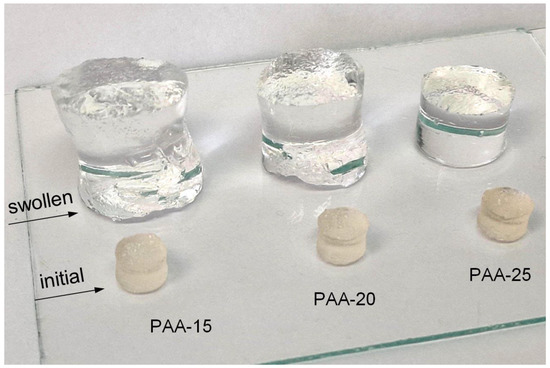
Figure 1.
The photographs of the PAA hydrogel cylinders.
The degree of crosslinking determines the density of the network and regulates the structure, swelling, and mechanical behavior of PAA hydrogels. During the rise in AA concentration, a more densely crosslinked network of the gels is formed because of the increase in PAA molecular mass and the appearance of interweaving AA chains. As a result, the gels are characterized by a lower capability of swelling. The degrees of crosslinking Ns, calculated according to the values of equilibrium Q for PAA-15, PAA-20, and PAA-25, were 118, 82, and 62, respectively [16].
The swelling processes of the resulting PAA gels, depending on the pH media, were investigated. It was shown that the PAA gels are pH-sensitive materials, and the effect of pH on their equilibrium degrees of swelling was described by curves demonstrating the maximal values of Q at pH = 11.2 (Figure 2). This effect was more pronounced for the gels characterized by lower degrees of crosslinking. The slight swelling of the samples in acidic media was due to the fact that PAA is a weak polyelectrolyte, which is poorly dissociated and in a compressed state. The curves in Figure 2 demonstrate the region of rapid growth, i.e., of the highest pH-sensitivity, in the pH interval from 8 to 11. Upon an increase in the pH the carboxyl groups in PAA are converted into salt form, and the resulting salt (sodium polyacrylate) has a higher degree of dissociation and, consequently, a higher degree of swelling. The formation of sodium acrylate was confirmed by IR spectroscopy (Figure 3). In strongly alkaline media, the screening of charges by an excess of sodium ions leads to the suppression of the polyelectrolyte swelling. Previously, the maximum pH dependence of Q for polyacrylate sodium gels was observed in the work referenced in [17] and calculated theoretically in that referenced in [18].
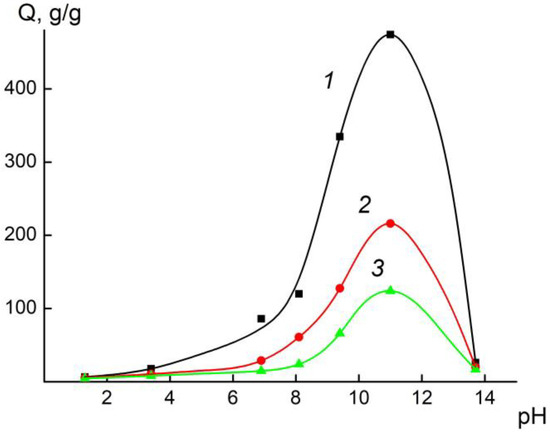
Figure 2.
The dependences of the swelling degree on the pH of the medium for the PAA gels PAA-15 (1), PAA-20 (2), and PAA-25 (3).
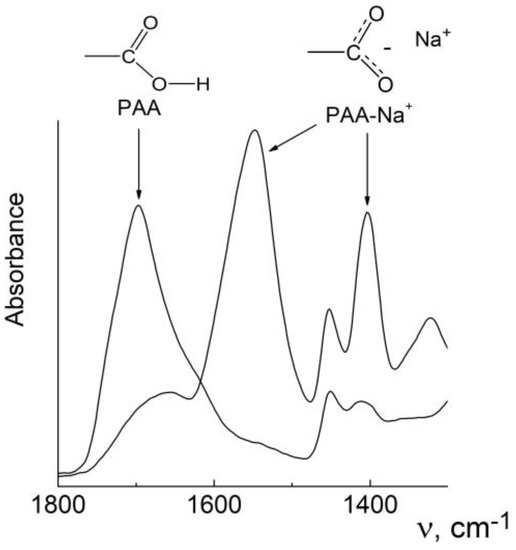
Figure 3.
IR spectra of the PAA matrices: the initial one and the sample dried after swelling in a medium with pH = 11.2.
The equilibrium degrees of swelling of the PAA gels were reached within the same period (approximately 5 days) for all media, except for the medium with pH = 1.3 (the process lasted 4 days), i.e., in a strongly acidic medium, where Q had minimal value.
The studies of the gels’ contraction in air after swelling in media of various acidities showed that the swelling/contraction process of the PAA gels is reversible when swelling occurs in neutral or acidic media (Figure 4).
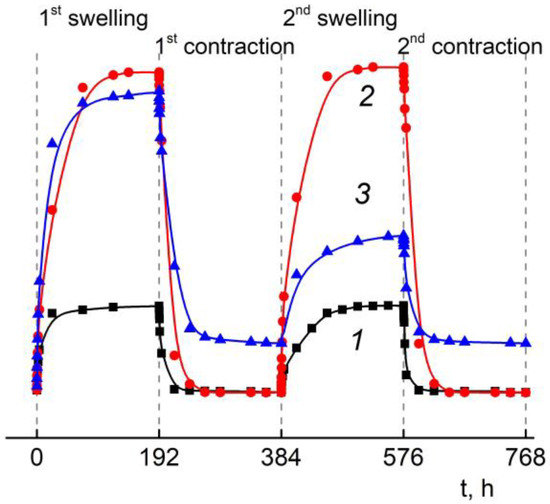
Figure 4.
Reversibility of the processes of swelling/contraction for the PAA-25 gels in pH = 1.3 (1), 6.4 (2), and 13.7 (3).
At the same time, the gels swollen in alkaline media (pH > 8) demonstrated irreversible behavior, and the mass of the gels after drying was higher than that of the initial gel before the experiment. This effect was due to the fact that the swelling of PAA in media with high pH levels is accompanied by the replacement of acid protons by Na+ ions with the formation of PAA-Na+, as well as by a corresponding increase in mass. This was confirmed by IR spectroscopy, which demonstrated the spectra of sodium polyacrylate PAA Na+ for the dried gels [16]. Moreover, for the gels swollen in media with pH = 8.1 and 9.4, the increases in mass after drying were negligible (6–7%), while for the samples swollen at pH = 11.2 and 13.7, these increases were by 12–14 wt% and 150–250 wt% (!!!), respectively, depending on the crosslinking degree (Table 1). Thus, a significant increase in mass upon swelling may be due to the fact that sodium cations bring hydration water with them.

Table 1.
The change in the masses (Mc, %) of the PAA gels after the swelling/contraction process (the first cycle).
At the second swelling (Table 2), the swelling/contraction process of the PAA gels was reversible in all media except in a strongly alkaline one (pH = 13.7) where it was accompanied by a 12–16% loss of mass and decreases in the swelling degree from 26, 20, and 17 to 7–8% for all samples. This may be explained by the partial loss of hydration water and screening of gel by the large amount of Na+ cations preventing swelling.

Table 2.
Degrees of swelling of the PAA matrix for the first and second cycles of swelling.
The mechanical characteristics of the gels were measured immediately after the preparation of the gels swollen in water, and they were calculated using stress–strain curves (Figure 5). The investigations of the compression deformation have demonstrated that the loading–unloading processes yield almost identical stress–strain relationships. During the measurements, no losses of mass were observed for the samples when they were compressed, and the gels retained their volume.
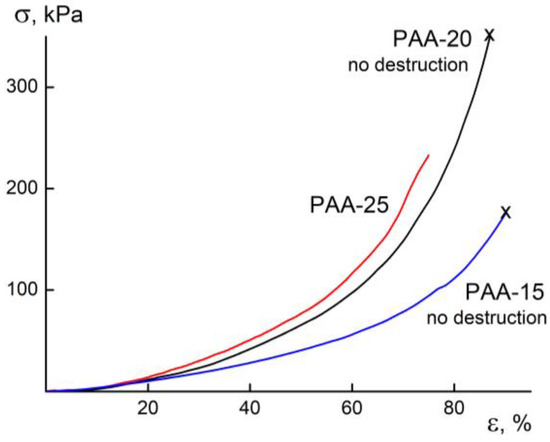
Figure 5.
Stress–strain curves for the swollen PAA gels.
The stress–strain dependences of σ vs. (λ − λ−2) for these gels were practically linear, within 65% of compression. It can be seen in the Table 3 that the more tightly crosslinked gels had higher elastic moduli, and the most rigid gel PAA-25 was destroyed under the stress arising in the sample during compression. The samples PAA-15 and PAA-20 retained their mechanical integrity and exhibited elastic deformation under the loads that were used. After unloading, these samples returned to their original cylindrical shapes and retained their initial masses and visual transparency levels.

Table 3.
Mechanical characteristics of the PAA hydrogels swollen in water (pH = 6.4).
3.2. The Electroactive Gel Composites
3.2.1. The Composites’ Preparation Procedure
In the composites under study, the conducting polymer phase was formed directly in the PAA matrix using a two-stage preparation method, according to the scheme shown in Figure 6.
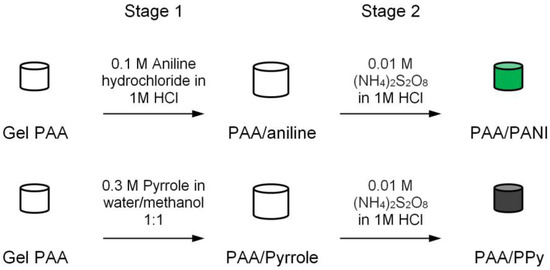
Figure 6.
Scheme of the two-stage preparation method of the PAA/PANI and PAA/PPy composites.
The morphological details of the matrix and the composites’ structures were investigated by electron microscopy. It can be seen in Figure 7 that the samples were rather homogeneous in structure, but they were formed by different structural elements. The matrix consisted of interconnected smooth elements (Figure 7a), but the structures of the composites contained fairly large, irregularly-shaped elements (approximately 230–260 nm) in the PAA/PANI samples and well-defined spherical particles 85–95 nanometers in size combined in the dense clusters of the PAA/PPy samples.
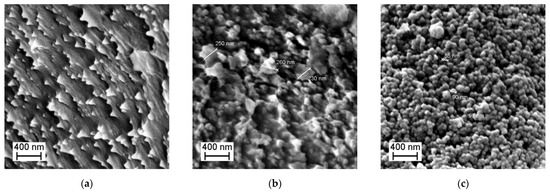
Figure 7.
Electron microscope pictures of the PAA-20 matrix (a) and the composites PAA-20/PANI (b) and PAA-20/PPy (c).
Using the preparation procedure presented in Figure 6, the block cylindrical samples of the composite materials were obtained (Figure 8). The composites had the specific colors of the selected conductive polymers—emerald for polyaniline and black for polypyrrole. Figure 8 clearly illustrates that the cylinder’s composites appeared to be different—PAA/PANI (Figure 8a) was more smooth and dense, and even had a shiny side surface, while PAA/PPy (Figure 8b) was rough and irregularly fragmented. Thus, although the composites had the same matrix and similar active components, the structure formation in the PAA/PANI and PAA/PPy block samples had different characteristics.
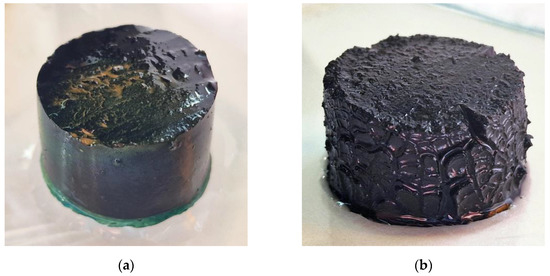
Figure 8.
The photographs of the composite hydrogel cylinders PAA/PANI (a) and PAA/PPy (b).
As seen in Table 4, the mass content of the conducting component in the PAA/PPy composite was lower than in PAA/PANI. It was observed that during the polymerization process of PPy, the solution around the gel turned black, indicating a significant amount of pyrrole released into the solution from the swollen gel. At the same time, the low coloration of the oxidant solution during the polymerization of aniline indicated a slight release of the monomer into the surrounding solution, and, as a result, a greater content of PANI in the composite. The content of PANI weakly depended on the crosslinking degree, but the structure of the strongly crosslinked gel PAA/PPy significantly prevented the penetration of pyrrole into the volume of the gel. The content of PPy in the PAA-25/PPy gels fell to 2%.

Table 4.
Content of conducting component (X, %) in the composites PAA/PANI and PAA/PPy.
It has been observed that conducting polymers in these composites are formed on the surfaces and in the near-surface volumes of the PAA gels. It is possible to assume that these coatings hinder the deeper entry of the oxidizing agent into the gel volume.
3.2.2. Swelling of the Electroactive Gel Composites
Although the swelling process was controlled by the PAA matrix, the swelling degrees of the composites were much lower than ones for the PAA gels, since the dense layer of the rigid-chain conducting polymer blocked the penetration of liquid into the gel. This effect was especially pronounced when the composite is swollen in either neutral or alkali media, where the matrix PAA gels had very high swelling degrees in media with pH values = 9.4 and 11 (Table 5, data for the matrices are given in brackets). As a result, the blocking effect of PANI and PPy components led to a disturbance of the regular dependence Q on pH that was observed for the matrix PAA (Figure 2). However, the excess of swelling in an alkaline medium (as compared with other media) for the composites was preserved. It is possible to say that the lower swelling degree for the PAA matrix led to the weaker effect of the conducting layer on the swelling of the composite—the lowest influence was observed for swelling at pH = 13.4, where the degree of swelling was close to one for the matrix. It can be assumed that the increase in the swelling degree for the composites PAA-20/PPy and PAA-25/PPy in pH = 11.2 was related to some destruction of the conducting coating under the “moving” of the matrix to an equilibrium swelling degree of Q, which is extremely high. An additional factor affecting the resulting swelling degree of the composites was the above-mentioned difference in the structures of the conducting components.

Table 5.
Swelling degrees for the PAA matrices (in brackets) and the composites PAA/PANI and PAA/PPy (the first swelling).
The first cycle swelling/contraction for the composite gels was accompanied by mass losses at swelling in all utilized media, except one with pH = 13.4 (Table 6). The effect was more strongly pronounced for PAA/PPy than for PAA/PANI, which is supported by the visual observations mentioned above. However, the values of mass losses were not so high. At the same time, in the medium with pH = 13.4, the composites demonstrated significant mass gains related to the transformation of PAA in PAA Na+ in the alkali solution NaOH. Naturally, the greatest mass gains were observed for the composites in the weakly crosslinked matrices (PAA-15), which were able to absorb a larger volume of the liquid medium during swelling.

Table 6.
The changes in mass (Mc, %) after the swelling/contraction process for the composites PAA/PANI and PAA/PPy (the first cycle).
The second cycle of swelling/contraction for the composites was reversible during swelling in media with pH < 9.4. In alkali media with pH = 9.4 and 11.2, the degrees of swelling were higher than those of the 1st cycle due to the partial destruction of the conducting coating during the previous cycle of swelling/contraction. But these Q were still lower than those for PAA matrices because the restricting effect of the rigid conducting layer was preserved. For the medium with pH = 13.4, the swelling degree at the second cycle was lower than that at the 1st one, and close to Q for the matrix. It should be noted that the maximum swelling at pH = 11.2, which is shown for the PAA matrices (Figure 2), was not observed as significantly at the 1st as at the 2nd swelling for the composites. It is possible to say that the complex influence of several different factors does not lead to regular dependence of Q on pH for the composites, as takes place for the matrixes.
3.2.3. Conductivity and Mechanical Properties of the Composites
The electroactive component layer imparted electroconductive properties to the composite. In particular, the dark green color of the PAA/PANI composites mentioned above indicated the formation of PANI in salt (conductive) form. A decrease in the conducting component content led to a regular diminishing of the gel conductivity in dry and in swollen states of the composites (Table 4, Table 7, and Table 8). It is possible that the lower content of the conducting component in the composites PAA/PPy than in the PAA/PANI ones was related to the weaker interaction of the acid gel with pyrrole (polypyrrole monomer) than with aniline. Due to the higher content of conducting polymer in the PAA/PANI composites, they are characterized by higher electric conductivity than PAA/PPy (Table 7 and Table 8). As a result, the conductivity of the PAA/PANI gels was considerably higher (by 1 order of magnitude) than that of the PAA/PPy composites. The more homogeneous and dense structure of the PANI layer as compared with the loose uneven one of PPy (Figure 8) also positively influenced the composite’s conductivity. It should be noted that the achieved values of conductivity were the highest observed for conductive polymer gels [19,20,21,22].

Table 7.
The characteristics of the PAA/PANI gel composites.

Table 8.
The characteristics of the PAA/PPy gel composites.
The fixation of the PAA matrices and its partial destruction by the rigid-chain conducting component introduced stresses into the composites, which effected their deformational properties in a complex way (Figure 9). It can be seen in Table 8 that the tensile strength for the composites PAA/PPy grew remarkably with an increase in the degree of crosslinking of the PAA matrix in spite of a decrease in the PPy content, but their strength was lower than that of the matrix. This can explained by the discretely organized morphology of the PPy component, which inserted defects in the composite structure. The content of PANI weakly depended on the crosslinking degree of the matrix, and the changes in strength were also minor, but the strength of these composites was higher than that of the matrix. This is correlated with the observed formation of the dense homogeneous structure of the component (Figure 8), which strengthened the composites. It is quite clear that the rigid-chain component imparted an increase in the modulus of elasticity as compared with the matrix. At the same time, the elasticity (deformation at destruction) for the PAA/PANI samples practically remained the same as for the matrix, while for PAA/PPy, it was reduced. For both types of composites, the elasticity weakly depended on the crosslinking degree of the matrix. It is possible to conclude that the introduction of a functional conducting component does not degrade the mechanical properties of the PAA matrix, and the composites retain sufficient elasticity despite an increase in the elastic modulus.
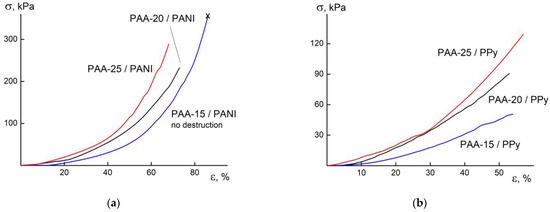
Figure 9.
Stress–strain curves for the swollen PAA/PANI (a) and PAA/PPy (b) gels.
4. Conclusions
The composite hydrogels based on PAA as a matrix and the conducting polymers PANI and PPy as active components are functional stimuli-responsive systems combining the properties of two classes of polymeric materials: electroconductivity and the ability to induce changes in geometric dimensions. Conducting components impart electronic conductivity and redox activity to the composites, while the PAA hydrogel matrix gives them pH sensitivity, mechanical integrity, and elasticity.
In this work, the hydrogels of PAA as matrices for the composites were prepared by varying the degree of crosslinking, as were the composites containing PANI and PPy, using all these matrices. As a result, a sample set of swelling systems of different types and compositions was obtained. It is essential to note that the studies on the morphological structures and properties of the matrices and hybrid systems were performed using samples prepared as cylindrical blocks. It is proven that the PAA matrices actually provide mechanical integrity, strength, and elasticity to the composites. This systematic investigation permitted us to establish the influence of each component (its nature and content) on the characteristics of the samples—the swelling behavior in media of varied pH levels and mechanical and electrical properties.
For the first time, the complete dependences of the swelling degree Q on the acidity of the medium in the entire range of pH sensitivity of the samples were obtained for the PAA matrices and the electroconducting composites based on them. It was shown that these dependences demonstrated the maximum correspondence to the swelling in alkaline media (pH = 11), and the pH sensitivity was more strongly expressed for the gels with a lower degree of crosslinking. For the matrices and the composites, the reversibility of the swelling/contraction processes, which is one of the main characteristics of hydrogel systems, was estimated and analyzed. It was demonstrated that full reversibility of the swelling/contraction processes in acidic and neutral media was achieved for the PAA matrices as well as for the composites. At the same time, the swelling in strongly alkaline media was irreversible because of the transformation of PAA in sodium acrylate salt. These results were confirmed by changes in the degrees of swelling and in the samples’ masses in the first and second swelling/contraction cycles. Such studies have not been performed before.
The obtained results are a new contribution to the scientific understanding of the properties and behavior of the acrylate gels and electroactive hydrogel composites. This study provides important information regarding the use of such systems in multiple swelling/drying processes in various conditions. The unique combination of functional properties—electroconductivity and the ability to regulated swelling—significantly expands the possibilities and areas of practical application for hybrid hydrogels. These are promising block materials which have demonstrated stimuli responsiveness, the ability to reverse large-scale volume changes, and mechanical elasticity.
Author Contributions
Contributed to the conceptualization, analysis, writing and editing, and validation, G.E.; contributed to the experimental work of the research, interpretation of data, and data reconciliation, E.R.; contributed to the experimental work of the research and methodology, Z.Z.; contributed to the experimental work of the research and methodology, N.S.; contributed to the experimental work of the research and data reconciliation, I.K. All authors have read and agreed to the published version of the manuscript.
Funding
The work is supported by the Program of Fundamental Investigations, Ministry of Science and Education of the Russian Federation. This work was carried out as part of State Assignment 122012000449-9 (2021–2023).
Data Availability Statement
The data presented in this study are available upon request from the corresponding author.
Conflicts of Interest
The authors declare that they have no known competing financial interests or personal relationships that could have appeared to influence the work reported in this paper, and also declare that they have no conflict of interest.
References
- Barbero, C.A. Functional materials made by combining hydrogels (cross-linked polyacrylamides) and conducting polymers (polyanilines)—A critical review. Polymers 2023, 15, 2240. [Google Scholar] [CrossRef] [PubMed]
- Sánchez-Fernández, J. Structural strategies for supramolecular hydrogels and their applications. Polymers 2023, 15, 1365. [Google Scholar] [CrossRef] [PubMed]
- Caccavo, D.; Cascone, S.; Lamberti, G.; Barba, A. Hydrogels: Experimental characterization and mathematical modelling of their mechanical and diffusive behaviour. Chem. Soc. Rev. 2018, 47, 2357–2373. [Google Scholar] [CrossRef] [PubMed]
- Sahiner, N.; Demirci, S. Conducting semi-interpenetrating polymeric composites via the preparation of poly(aniline), poly(thiophene), and poly(pyrrole) polymers within superporous poly(acrylic acid) cryogels. React. Funct. Polym. 2016, 105, 60–65. [Google Scholar] [CrossRef]
- Gareev, K.; Bagrets, V.; Golubkov, V.; Ivanitsa, M.; Khmelnitskiy, I.; Luchinin, V.; Mikhailova, O.; Testov, D. Synthesis and characterization of polyaniline-based composites for electromagnetic compatibility of electronic devices. Electronics 2020, 9, 734. [Google Scholar] [CrossRef]
- Tomczykowa, M.; Plonska-Brzezinska, M. Conducting polymers, hydrogels and their composites: Preparation, properties and bioapplications. Polymers 2019, 11, 350. [Google Scholar] [CrossRef]
- Kougkolos, G.; Golzio, M.; Laudebat, L.; Valdez-Nava, Z.; Flahaut, E. Hydrogels with electrically conductive nanomaterials for biomedical applications. J. Mater. Chem. B 2023, 11, 2036–2062. [Google Scholar] [CrossRef]
- Sharma, K.; Kumar, V.; Chaudhary, B.; Kaith, B.S.; Kalia, S.; Swart, H.C. Application of biodegradable superabsorbent hydrogel composite based on Gum ghatti-co-poly (acrylic acid-aniline) for controlled drug delivery. Polym. Degrad. Stab. 2016, 124, 101–111. [Google Scholar] [CrossRef]
- Liu, K.; Wei, S.; Song, L.; Liu, H.; Wang, T. Conductive hydrogels—A novel material: Recent advances and future perspectives. J. Agric. Food Chem. 2020, 68, 7269–7280. [Google Scholar] [CrossRef]
- Zhang, T.; Deng, H.; Xie, Z.; Liu, R.; Yang, J.; Liu, C.; Wang, X.; Fang, Q.; Xiong, Y. Recent progresses on designing and manufacturing of bulk refractory alloys with high performances based on controlling interfaces. J. Mater. Sci. Technol. 2020, 52, 29–62. [Google Scholar] [CrossRef]
- Huang, Y.; Xiao, L.; Zhou, J.; Li, X.; Liu, J.; Zeng, M. Mechanical enhancement of graphene oxide-filled chitosan-based composite hydrogels by multiple mechanisms. J. Mater. Sci. 2020, 55, 14690–14701. [Google Scholar] [CrossRef]
- Chen, H.; Zhou, L.; Fang, Z.; Wang, S.; Yang, T.; Zhu, L.; Hou, X.; Wang, H.; Wang, Z. Piezoelectric nanogenerator based on in situ growth all-inorganic CsPbBr3 perovskite nanocrystals in PVDF fibers with long-term stability. Adv. Funct. Mater. 2021, 31, 2011073. [Google Scholar] [CrossRef]
- Xue, Y.; Yang, T.; Zheng, Y.; Wang, E.; Wang, H.; Zhu, L.; Du, Z.; Hou, X.; Chou, K. The mechanism of a PVDF/CsPbBr3 perovskite composite fiber as a self-polarization piezoelectric nanogenerator with ultra-high output voltage. J. Mater. Chem. A 2022, 10, 21893–21904. [Google Scholar] [CrossRef]
- Xue, Y.; Yang, T.; Zheng, Y.; Wang, K.; Wang, E.; Wang, H.; Zhu, L.; Du, Z.; Chou, K.; Hou, X. Heterojunction engineering enhanced self-polarization of PVDF/CsPbBr3 /Ti3 C2 Tx composite fiber for ultra-high voltage piezoelectric nanogenerator. Adv. Sci. 2023, 11, e2300650. [Google Scholar] [CrossRef]
- Skotheim, T.A.; Reynolds, J. (Eds.) Conjugated Polymers: Theory, Synthesis, Properties, and Characterization; Handbook of Conducting Polymers, 3rd ed.; CRC Press: Boca Raton, FL, USA, 2006; 1024p. [Google Scholar]
- Bel’nikevich, N.G.; Bobrova, N.V.; Elokhovskii, V.Y.; Zoolshoev, Z.F.; Smirnov, M.A.; Elyashevich, G.K. Effect of initiator on the structure of hydrogels of cross-linked polyacrylic acid. Russ. J. Appl. Chem. 2011, 84, 2106–2113. [Google Scholar] [CrossRef]
- Elyashevich, G.K.; Bel’nikevich, N.G.; Vesnebolotskaya, S.A. Swelling-contraction of sodium polyacrylate hydrogels in media with various pH values. Polym. Sci. Ser. A 2009, 51, 550–553. [Google Scholar] [CrossRef]
- Kramarenko, E.Y.; Philippova, O.E.; Khokhlov, A.R. Polyelectrolyte networks as highly sensitive polymers. Polym. Sci. Ser. C 2006, 48, 1–20. [Google Scholar] [CrossRef]
- Stejskal, J. Conducting polymer hydrogels. Chem. Pap. 2017, 71, 269–291. [Google Scholar] [CrossRef]
- Wang, H.H.; Lin, J.Y.; Shen, Z.X. Polyaniline (PANi) based electrode materials for energy storage and conversion. J. Sci. Adv. Mater. Devices 2016, 1, 225–255. [Google Scholar] [CrossRef]
- Wei, D.L.; Lin, X.; Li, L.; Shang, S.M.; Yuen, M.C.W.; Yan, G.P.; Yu, X.H. Controlled growth of polypyrrole hydrogels. Soft Matter 2013, 9, 2832–2836. [Google Scholar] [CrossRef]
- Vlasov, P.V.; Dmitriev, I.Y.; Elyashevich, G.K. The 3D electrode material based on polyacrylate hydrogels and conducting polyaniline. Smart Nanocompos. 2016, 7, 135–139. [Google Scholar]
Disclaimer/Publisher’s Note: The statements, opinions and data contained in all publications are solely those of the individual author(s) and contributor(s) and not of MDPI and/or the editor(s). MDPI and/or the editor(s) disclaim responsibility for any injury to people or property resulting from any ideas, methods, instructions or products referred to in the content. |
© 2023 by the authors. Licensee MDPI, Basel, Switzerland. This article is an open access article distributed under the terms and conditions of the Creative Commons Attribution (CC BY) license (https://creativecommons.org/licenses/by/4.0/).